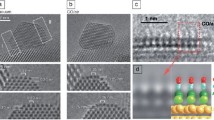Abstract
Solid/liquid interfaces are important locations for various chemical reactions, such as electrode chemical reactions and metal corrosions. Conventional surface analytical methods, such as XPS and SEM-EDS, have been applied to solid materials after being removed from the liquid phase. These methods do not involve direct observation, although useful information is available. It is important to directly observe surface reactions on solid materials in the liquid phase in order to understand the details of these reactions. One feasible method of doing this is 3D micro-XRF analysis. The confocal 3D micro XRF method enables nondestructive x-ray elemental analysis of localized microspace. We have applied a confocal 3D micro-XRF instrument for solid/liquid interface analysis. This technique was applied for direct observation of the chemical deposition of Cu on an Fe plate and the dissolution of Fe in a CuSO4 solution.
Similar content being viewed by others
References
“An Introduction to Surface Analysis by XPS and AES.”, J. F. Watts and J. Wolstenholme, 2002, John Wiley & Sons, Inc.
“Handbook of X-Ray Spectrometry.”, ed. R. Van Grieken and A. A. Markowicz, 2nd ed., 2002, Marcel Dekker Inc., New York.
K. Tsuji, in “Kirk-Othmer Encyclopedia of Chemical Technology.”, ed. A. Seidel, 5th ed., 2007, Vol. 26, John Wiley & Sons, Inc., 411.
X. Ding, N. Gao, and G. Havrilla, Proceedings of SPIE. 2000, 4144, 174.
B. Kanngieβer, W. Malzer, and I. Reiche, Nucl. Instrum. Methods Phys. Res., Sect. B. 2003, 211, 259.
L. Vincze, B. Vekemans, F. E. Brenker, G. Falkenberg, K. Rickers, A. Somogyi, M. Kersten, and F. Adams, Anal. Chem., 2004, 76, 6786.
G. J. Havrilla and T. Miller, Powder Diffr., 2004, 19, 119.
K. Tsuji, K. Tanaka, Y. Matsuoka, A. Okhrimovskyy, and X. Ding, Abstract Book of 18th International Conference on Xray Optics and Microanalysis (ICXOM 2005), 2005, 102.
K. Tsuji, K. Nakano, and X. Ding, Spectrochim. Acta, B. 2007, 62, 549.
K. Nakano and K. Tsuji, Bunseki Kagaku. 2006, 55, 427.
K. Tsuji and K. Nakano, X-Ray Spectrom., 2007, 36, 145.
Z. Smit, K. Janssens, K. Proost, and I. Langus, Nucl. Instrum. Methods Phys. Res., Sect. B. 2004, 35, 219.
A. R. Woll, J. Mass, C. Bisulca, R. Huang, D. H. Bilderback, S. Gruner, and N. Gao, Appl. Phys. A. 2006, 83, 235.
K. Tsuji, K. Tsutsumimoto, K. Nakano, K. Tanaka, A. Okhrimovskyy, Y. Konishi, and X. Ding, Adv. X-Ray Anal., 2006, 49, 296.
K. Tsutsumimoto and K. Tsuji, Bunseki Kagaku. 2007, 56, 499.
Author information
Authors and Affiliations
Corresponding author
Rights and permissions
About this article
Cite this article
Tsuji, K., Yonehara, T. & Nakano, K. Application of Confocal 3D Micro-XRF for Solid/Liquid Interface Analysis. ANAL. SCI. 24, 99–103 (2008). https://doi.org/10.2116/analsci.24.99
Received:
Accepted:
Published:
Issue Date:
DOI: https://doi.org/10.2116/analsci.24.99




